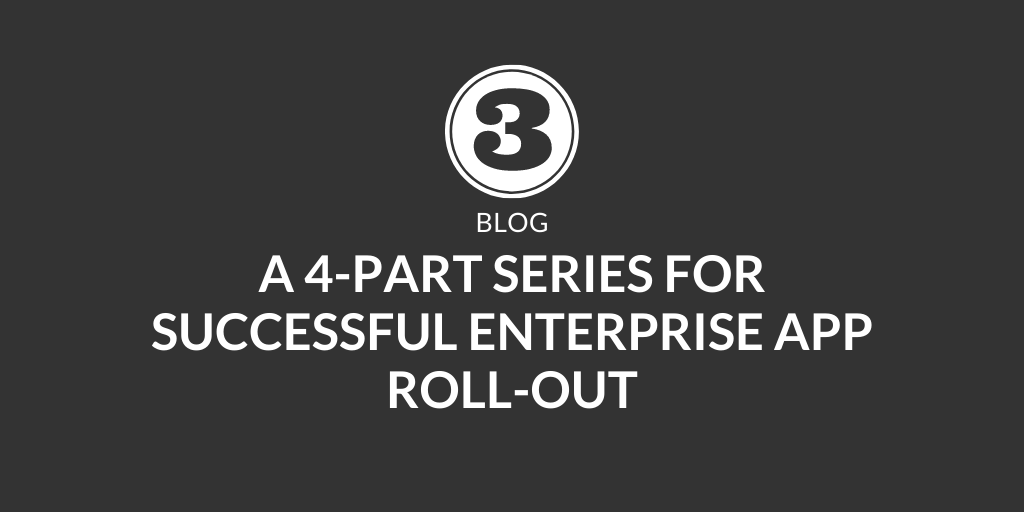So, at this point you’ve shared internal communications, designed an experiential launch party, increased cross-organizational awareness, and prepared yourself for a successful mobile program roll-out. Everything is in place, and we now think you’re ready to start on-boarding customers by sharing your mobile app.
But all of that - every single bit of work and time invested - is for naught if you don’t get your excited, engaged, and set-up within the app itself.
To make things a bit trickier, not just anyone can discover, download, and install your app. You are engaging with a small subset of your total audience - people who will be attending your event(s) or customer experience center - which may already be incredibly niche.
How then do you get the word out? More importantly, how do you ensure perpetual engagement from your audience, customers, and community?
At this point, customer communications is mission critical. Your message must be clear, concise, and more importantly captivating.
Whatever messaging medium you choose - be it email or something else - you must define your app, the benefits it will offer, and why your customers should even care.
Focus on Your Messaging
This is your moment. The time when you have an opportunity to put together a clear set of objectives that will help you achieve your mission or goal. You already decided that you want a digital mobile app to provide your customers with a unique experience and that it will offer perpetual engagement leading up to the appropriate time. Don’t backpedal, put everything you have into making this work.
It’s all about putting your ideas and concepts into action. Naturally, this is done through your business messaging efforts, alternatively your customer interactions. We’ll discuss in greater detail how to convey this to your audience, or more specifically how to get them interested.
What you need to focus on, is deploying this message in a constructive, engaging way. Don’t be afraid to think outside the box.
Onboarding campaigns that make use of a push notifications or alternate channel message - such as email, in-app messaging or news feed updates - within the first week of being installed can increase customer retention by as much as 130% over just a couple months.
Identify Unique Features
You’re most likely not going to have the space or capacity to sit down with each customer and discuss the app. You have a very small window to pique their interest and outline your value propositions, almost a 90-second window. You’ll want to highlight the most important features your power users can expect to take advantage of.
One clear cut way to do this is to share a problem and explain how your app or feature is a solution to said problem. It helps to use real-world case studies and examples, which your customers can relate to. The idea here is to ensure everything your app has to offer resonates with your most viable customers.
You won’t be able to speak to everyone, that much is certain. However, you can put your best features and benefits in the spotlight.
Provide Clear Instructions and Suggested Operations
This is a critical step to explain and provide instructions for getting the app working on user device(s) seamlessly. Be sure you cover the on-boarding process as simply and easily as you can. Obviously the first step is to provide direct links to appropriate app stores for download.
What is just as critical, however, is explaining to your audience what they need to do next. After they installed the app and signed up for a personal account, are they done? No, and you need to be certain they understand this.
Encourage everyone to setup and customize their profile, and make sure various details are filled in. This gets the entire community kickstarted, and ensures the appropriate parties are engaging with the app, at least to start. Once you have everyone signed up - or in - and their details are all shared, you can begin focusing on getting them using the app and various features.

Tailor Your Use Case
For each potential use case, it’s important to have a unique benefit positioning statement that directly tells your users what they are getting out of the deal. Why do they want to use your app? Why should they keep using it after they have it installed on their device(s)?
Apps For Meetings and EBCs:
At some point, you’ll have a meeting - virtual or otherwise - where you lay out your company briefing and familiarize everyone with your mission and goals. Most brands will have an internal form of this through an investor or EBC meeting, but they will also have an external form where they invite the public and customers to participate or attend.
Don’t underestimate the benefits of a deploying mobile-first strategy for achieving such a thing. Consider the fact that users download on average about 8.8 apps per month, with app installs up 5% year over year. You want to be where they are.
Your mobile app must be the place where your customers can and will go. This means having delivering a full-scale communications hub where users can interact with one another.
Starting out, it’s going to be tough getting that amount of app stickiness so make sure you encourage your internal team and cross-functional groups to participate as much as possible. If your customers see others using the app and services, they will be more inclined to do so.
Apps For Events:
Social media platforms and apps perform so well on mobile because they are evergreen and active. Whether you’re jumping on a platform to share your opinions, see the thoughts and expressions of others, stay entertained, or simply be informed you know at any given time that a social network is a great place to do all of that.
Having a real-time agenda for events is just table stakes. But an integrated approach to mobile event apps is what attendees expect. They want apps and services that talk to each other and help them connect more efficiently and effectively leading up to and on-site at events.
Revealing some of your program’s advanced features and capabilities are big ticket items that will increase overall event success and ensuring attendees are getting the most out of their experience hopefully getting them to stay longer, engage more often, and continue a relationship with your organization.
Apps For Communities:
There’s no point in sugar-coating the obvious. Your customers and audience are going to be turning to a virtual community anyway. Most likely it will offer everything they need to stay in the loop, including fast facts and news, networking tools, and additional insights that impact or influence their industry or community.
Users spend about 90% of their time in apps compared to the mobile web.
Why give them the option to go elsewhere for this. Provide it to them, in real-time with your service(s), and you’ll have their support. You need the kind of digitization that can only be achieved through a mobile app.
Provide Ongoing Support
The most important part of good customer experience is great customer service. So if you’re going to ask people to do you a favor and install your app and use it, be there to offer support, guidance and answer questions or solve technical problems as needed.
This is an ongoing element for maintaining great customer experience, but even more so when it comes to a mobile app program, where business and collaboration can exist independently of face to face interaction through and autonomous customer journey.
You’re asking people to put their faith in your app and brand. Don’t leave them out in the cold when they experience setbacks or technical problems. Make sure you do everything in your power to fix or remedy a situation and offer as much support as humanly possible.
There are a few ways to do this if you don’t have the resources to prop up your support system within the app itself through notifications, polls, surveys, and a support alias. You can even crowdsource the efforts by deploying a community forum where your audience can interact and help one another.
Whatever the case, make sure there’s a system in place for your audience to get the assistance they need. We’ll explore this in more detail as we move to the last chapter to address Post-Launch requirements for a successful mobile app customer experience program.


